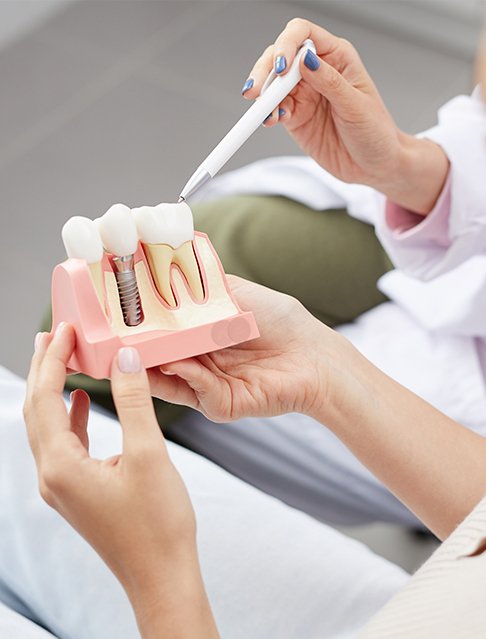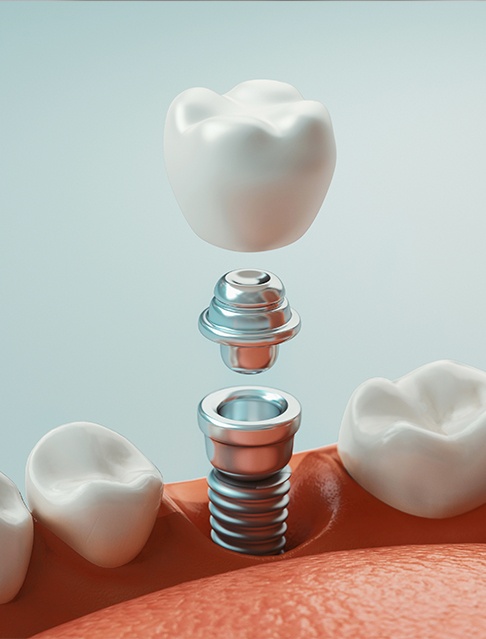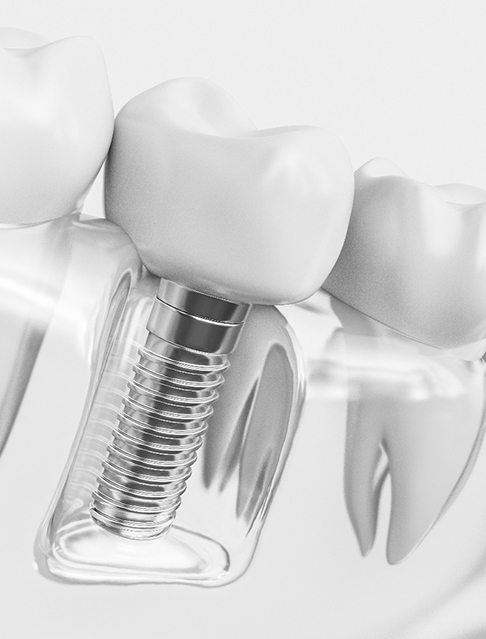

Over the last few decades, dental implants have emerged as the go-to treatment to restore smiles because of the wide array of unique benefits that they offer. Compared to traditional restorations, dental implants offer the same type of freedom that you had with your natural teeth—no denture adhesive, no slipping or shifting, no alteration of your dental structure—just a restored smile! To schedule a consultation and learn whether you’re a good candidate for dental implants in Marana, AZ, call our dental office!

Use the Arrows to Explore Our Services

Dental implants themselves are small, titanium posts that are surgically placed below the gumline to restore the root structure of missing teeth. Due to their biocompatible nature, they’re able to fuse with the jawbone and provide the structure with blood flow and stimulation to keep it from deteriorating. Once this process is complete, our team will be able to attach the restoration to finish your smile.

Restoring missing teeth with dental implants involves a much more complex process compared to other restorations like dental crowns or bridges. Unlike these options, you’ll be rebuilding your smile from the roots up. While this may seem overwhelming or time-consuming, you can enjoy results that’ll last a lifetime. At Sweet Smiles Family Dentistry and Orthodontics, our team is happy to explain each step of the process so that you know what to expect from your treatment. Read on or reach out to us today if you wish to learn more about how dental implants work in Tucson!
During your initial consultation, we’ll talk about your tooth replacement goals, assess your oral health, and determine if dental implants are the best option for you. Depending on what we find, you may need preliminary treatments before you can get started with the main procedure. This can include gum disease therapy or bone grafting if your gum tissue isn’t healthy, or you don’t have sufficient jawbone density to support the implants. Once these conditions have been addressed, you’ll have a better chance of successfully restoring your smile.
You’ll undergo minor surgery to place your dental implants in. Our team will refer you to a specialist for this step so that you receive the highest-quality care possible. Your oral surgeon will first numb your mouth, that way you remain comfortable throughout the procedure. They’ll then make a small incision in your gums to reach the jawbone. Your dental implant will be embedded into the bone tissue, and then your gums will be closed off around the metal post. We’ll then provide you with post-op instructions to help care for your implant site while you rest and recover.
Many patients typically take a few days to a week to heal from dental implant surgery. The main goal of your recovery process is to allow your jawbone to undergo osseointegration. This is where your implant bonds directly with your bone tissue, serving as your new permanent root. The process can take anywhere from three to six months to complete. Afterward, you’ll be given abutments or small connector pieces that are fitted atop your metal post. We’ll then take impressions of your teeth and send them to a dental lab to fabricate your restorations.
The final step of your treatment involves us delivering and attaching your restorations to your dental implants. Once we’ve received your personalized crown, bridge, partial, or denture, we’ll call you back so we can place them onto your abutment piece. After your restoration is securely fitted, we’ll discuss basic dental care guidelines and answer questions you have about your new smile. Our team will double-check that your teeth are comfortable and that you’re satisfied with your results before you leave. Then, you can enjoy your fully restored smile for years to come!

Dental implants have quickly become the gold standard of tooth replacement treatments, and it’s easy to see why! They offer a reliable and lasting solution for missing teeth with unique benefits that make them a cut above the competition. At Sweet Smiles Family Dentistry and Orthodontics, we recommend dental implants because we know how incredible they are and how much they’ve helped our patients. They not only restore smiles but also help preserve oral health! Read more below to discover the many excellent benefits of dental implants.
Once your implants are in place, you’ll begin to notice small, but convenient changes in the way your mouth functions every day. Here’s what you can expect:
It’s not just day-to-day comfort and convenience you’ll experience, but also an overall boost to your oral and physical health. Dental implants work behind the scenes to deliver benefits you might not normally think about, such as:
Once dental implants heal, they become a permanent fixture in your mouth, fusing to your jawbone. This, combined with their high success rate of over 95 percent, means that you’ll be able to enjoy their benefits for many years, providing:

The best way to learn whether you’re a good candidate for dental implants is to schedule a consultation with Dr. Fitzgerald. Our team will go over the process with you and discuss your needs and any goals that you have. Based on our diagnostic findings and what we’ve talked about, we’ll outline a treatment plan for you and walk you through how we can restore your smile with dental implants.
Since dental implants can help patients at all stages of tooth loss, you shouldn’t hesitate to schedule a consultation with Dr. Fitzgerald! At your appointment, she will take a look at your X-rays, learn about your dental history, ask you a few questions about your smile goals, and determine if you’re a good candidate for this innovative tooth-replacement option. Fortunately, even if you aren’t eligible right away, there’s a good chance that we can provide the necessary preliminary care, like gum disease treatment, so a healthy, complete, and beautiful smile isn’t out of reach for long.
Whether you’re missing one of your front teeth or a back molar, we have good news: we can give you a complete smile again with a dental implant. One of the biggest perks of this tooth-replacement solution is that it replaces both the root and crown of the tooth, ensuring that your jawbone is stimulated, your restoration doesn’t move, and no unwanted attention is drawn to your smile moving forward. Plus, with proper care, it can last for several decades!
Are you missing several teeth in a row? Then schedule a consultation with us to find out if you’re a candidate for an implant bridge. If you are, we can secure a bridge to two dental implants that are placed at either end of the gap in your arch. That way, no alteration of your existing teeth will be necessary. Instead, we can fill the open space in your smile with a custom restoration that looks and feels just like the real thing, allowing you to chew easily, speak clearly, and smile with complete confidence.
If they’re not fitted properly, traditional dentures can slip and shift in the mouth, negatively affecting your diet and confidence in the process. Fortunately, there is a more permanent and stable solution: implant dentures. If you decide this is the best tooth-replacement option for you, we’ll simply anchor your restoration with anywhere from four to eight dental implants placed along your arch. The final result will be a healthy, functional, and beautiful smile.

Dental implants are the best tooth replacement option out there. In addition to being perfectly stable and comfortable, dental implants are long-lasting. They can stay healthy for many decades after being placed. Since everyone’s treatment is different, the cost can vary quite a bit. During your consultation, we will go over the estimated cost of your treatment in detail. Until then, here are some things to think about.
In some cases, patients need to undergo preliminary treatments before they can get dental implants. This includes things like gum disease treatment, tooth extractions, bone grafting, and other services. You should consider the costs of these procedures if they apply to you. Fortunately, the cost of preliminary procedures is often partially covered by dental insurance. Just keep in mind that every plan is a little bit different, so it’s best to contact your provider ahead of time to confirm your coverage.
There are multiple factors that contribute to the cost of your dental implant treatment. Here are the ones that play the biggest role:
It’s tempting to try to save money by choosing a more affordable option, like dentures. While dentures are a good option for some people, they don’t provide the same long-lasting benefits that dental implants do. The truth is that you can actually end up saving money in the long run by choosing dental implants. First of all, with dental implants, you don’t need to worry about putting up money for frequent repairs or replacements every few years. You also don’t need to buy adhesives or soaking solutions. Since dental implants help to prevent serious oral health issues, you might be able to avoid costly restorative treatments later in life.
Dental insurance doesn’t usually cover the cost of dental implants. However, there are some exceptions to keep in mind. Parts of the final restoration and preliminary procedure are usually covered. However, dental insurance plans vary, so you should confirm this with your provider beforehand. If you need help understanding your plan or have any questions, don’t hesitate to reach out to one of our friendly team members.
If you don’t have dental insurance, this doesn’t mean that you are completely out of luck. By signing up for a KLEER® Membership Plan, you can receive many of the same benefits of dental insurance without all of the red tape. We are also happy to accept payments through CareCredit – a third-party financing company that can split the cost of your treatment into manageable monthly installments with little to no interest. For more information, contact us.

You’ve probably heard plenty about how incredible dental implants are, but they’re also one of the most sophisticated treatment in modern dentistry, meaning that there’s always more to learn about them. Everyone on the team here at Sweet Smiles has spent years coming to understand them, and we’re excited to share what we know with you at a consultation.
If you want to hear more about them before then, here are some answers to common questions patients tend to have.
Many kinds of tooth replacement, like dentures, are removable. This can be a double edged sword—it makes certain types of cleaning easier, but needing to remove your dentures to soak them gives you one more thing to keep track of.
Dental implants are surgically placed into the jaw, meaning that they aren’t removable except by a dental professional. That’s something worth considering before you get them.
It’s worth noting that implant dentures are sometimes an exception—the dental implants can’t be removed, but the denture may be able to. We’ll discuss this possibility with you if you’re interested in them.
If you’re worried that you’re too old to get dental implants, there isn’t much to be concerned about. So long as you’re in generally good health, there’s no upper age limit on who can get dental implants.
However, it can be a problem if you’re too young. Most people’s jaws continue growing into young adulthood, and if a dental implant is placed before then, it could impede that bone growth. For that reason, we usually won’t give dental implants to anyone under 18, and may even wait until later if we feel your jaw is still growing.
Any kind of surgery can be tricky for diabetic patients, and dental implants are no exception. If your diabetes is well-managed, your odds of implant success are comparable to those of people without diabetes.
However, if you have uncontrolled diabetes or chronically high blood sugar, that could potentially impede the process of the dental implant healing. This increases your chances of developing an infection, which is already a risk for diabetes patients.
We’ll be happy to work closely with your endocrinologist or primary care doctor to make sure that your dental implant is a success.
The answer is yes, dental implants feel startlingly natural. Once they’ve healed completely and have merged with your jawbone, the metal implant should feel a lot like the roots of your natural teeth. Eating and talking shouldn’t be difficult or uncomfortable.
The only caveat is that the tooth itself won’t have any nerve endings in it. This may slightly alter the nature of sensations you get from that part of the mouth, as they’ll be coming from the teeth and gums surrounding the implant as opposed to the tooth itself.